Photos Show Eruption at Mauna Loa, World's Largest Active Volcano

Mauna Loa, the world’s largest active volcano, began erupting earlier this week after nearly 40 years of no activity—the longest quiet period for the volcano in recorded history. I’ve been fascinated by the eruption since it began on Sunday and realized I had a lot of questions, including some that seemed pretty elementary, like, “how do volcanoes work, anyway?” and “is this eruption going to be bigger because the volcano waited so long?”
To get some answers, I called up volcanologist Jess Phoenix. Fortunately, she told me that when it comes to volcanology, “there are no stupid questions.”
Read more
So... How Do Volcanoes Work?

Volcanic activity, explained Phoenix is, in essence, “where the insides of the earth are leaking out onto the surface.”
Inside Earth’s subsurface is a substance known as magma, or rock that has melted due to the extreme temperatures in our planet’s interior. “It’s rock that is a solid, but it moves like a liquid,” Phoenix said. “It’s rock that can flow.” There are pockets of magma distributed close to Earth’s crust, as well as some pockets deeper in the mantle. If gases heating up inside that magma expand and get too hot, magma can leak out of Earth’s surface, especially in areas where the crust is thinner.
Exploding Pressure Cooker
Volcanoes are kind of like “a pressure cooker,” Phoenix said. “Rock on top of the volcano is acting like a cork, or a plug, or a seal. But at some point, the amount of pressure that is created by the expansion of volcanic gasses in that magma—it’ll be too much for the rock. Basically, your pressure cooker explodes.”
What’s Special About Mauna Loa?
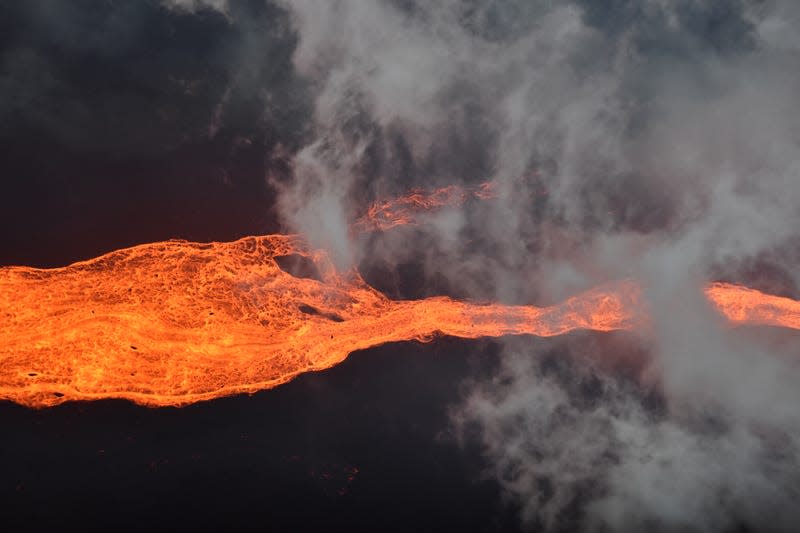
Mauna Loa is the world’s largest active volcano, but that doesn’t necessarily mean we’ll see a dramatic explosion as it erupts, because different kinds of volcanoes produce different types of eruptions. Volcanologists, Phoenix said, classify eruptions on a scale between “runny,” an effusive eruption where magma forms lava flows, and “sticky,” which produces explosions of magma, ash, and gas.
“Mauna Loa and the Hawaiian volcanoes typically produce very, very runny, very effusive eruptions,” she said. “So we’re not worried about a giant explosion—essentially, what people imagine is the worst-case scenario in Yellowstone.”
Gentle-Sloping Volcano
The shape of Hawaiian volcanoes actually reflect those runny eruptions. Mauna Loa is a category of volcano known as a shield volcano, which describes the long, gradual shape of its slope. “The reason it’s so gentle is because you don’t have these huge explosions—you have these oozy, runny lava flows that sort of leak out, decade after decade,” Phoenix said. “Then you’ve got this incredible volcanic structure that is built up one flow at a time.”
Could We Have Predicted This Eruption?
When it comes to knowing when any volcano is going to erupt, we’re out of luck. “We cannot predict eruptions,” Phoenix said. “That’s the most important thing to understand.”
The last time Mauna Loa erupted was in 1984; the lag time between then and now is the longest since modern recordings of eruptions began in the 1840s. But, as Phoenix points out, human history is tiny compared to the age of Earth, and 40 years is no time at all for the planet.
“In geologic time, this stuff happens in the blink of an eye,” Phoenix said. “In terms of the volcano’s million-year lifespan, for us, 40 years is long, but for a volcano, that happened yesterday. Mauna Loa is a baby in geologic time, and we are babies in Mauna Loa time.”
Volcanology Is a Young Science
Phoenix emphasizes that volcanology is a relatively new science, having only entered its modern era in the early 1980s. While eruptions themselves are impossible to predict, the science of keeping track of the symptoms of eruptions, like using seismometers around the volcano to record earthquakes that precede eruptions, taking measurements of gas emissions, and monitoring pressurized magma that could indicate a possible eruption, is getting better and better.
“What we are trying to do, what the scientific community has been moving towards, is having better forecasts for these eruptions,” Phoenix said. “And that means we monitor the heck out of volcanoes and actually protect people’s lives and property as best as possible. We’re a lot better prepared than we were even just a couple decades ago.”
How Long Will the Eruption Last?
Like predicting the eruptions themselves, figuring out or influencing what specifically is going to happen next at Mauna Loa isn’t possible. “It’s planet Earth—it kind of does what it’s going to do,” Phoenix said. “We don’t really have any influence over it. It could peter out in hours, or days, or it could last for years.”
Usually, Phoenix said, Mauna Loa’s eruptions can stretch over a year or two, but they can also be very long-lived, with the volcano erupting for years at a time. “The system needs to equilibrate again, it needs to reset, and the pressure needs to be released,” she said. “Once the pressure is out of the system, the eruption can stop. But, of course, we don’t know how much magma the deep plumbing of Mauna Loa is going to inject into the magma chamber and then push out.”
No Danger (Yet)
In an update posted Tuesday afternoon, the U.S. Geological Survey said that “several” fissures and lava flows were active on Mauna Loa but that there was currently “no property at risk.”
Because volcanoes are unpredictable, there is still a chance that lava could begin flowing toward places where people live, including Hilo, the densest population center on the island, as the eruption continues. “There’s not a lot that can be done” if the lava moves towards Hilo, Phoenix said. (In 1935, the Army dropped 20 600-pound bombs on a lava flow headed toward the city in an attempt to stop it. Whether it worked is still unclear.)
“The good news is that even if these flows reach inhabited areas, people can outwalk the vast majority of lava flows,” Phoenix said. “We can see, a lot of the time, where the flows are headed and we can warn people.”
Correction 11/30/22 2:oo PM ET: This post has been updated to correct the spelling of the city of Hilo.
Do Volcanoes Cause Climate Change?
The false idea that volcanoes release enormous amounts of carbon dioxide has been a popular meme among climate deniers for years. It’s true that volcanic activity causes an increase in atmospheric CO2 levels. But this contribution is absolutely minuscule compared to what we’re doing to the planet: NASA estimates that human activity creates the equivalent amount of CO2 as a Mount St. Helens-size eruption once every two and a half hours (!).
“Volcanoes erupt all the time,” Phoenix said. “There’s about 45 volcanoes erupting right now as we speak. It’s totally normal. Because we have this constant state of eruptions, people always say, oh, volcanoes produce so much CO2. But the Earth is used to this.”
Some volcanic eruptions, in fact, can have the reverse effect: particles from the eruption block out some sunlight and actually help lower temperatures. Some enormous explosions from the past, including Mount Pinatubo’s eruption in 1991, were responsible for cooling the Earth for a number of years after the explosion.
“Their eruptions produce particles that actually insulate us from the sun and help cool temperatures, which we see with those giant eruptions from the past. “Mauna Loa is not going to be like that,” Phoenix said. “The hazard we’re going to see is to folks living in the path of any potential lava flows.”
More from Gizmodo
Sign up for Gizmodo's Newsletter. For the latest news, Facebook, Twitter and Instagram.

